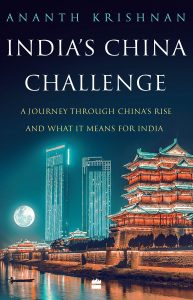
Scholars around the world have been debating about the emergence of China as a global power for some time now. India’s China Challenge is another book on the same subject where the author attempts to examine the transformation China has gone through in the last few decades and the challenges India faces from a belligerent China. The author has tried to provide a realistic picture of the same through his interviews and interactions with scholars, tech entrepreneurs and journalists based out of China. He has also penned his various observations that he noted during his travels across the country.
Ananth Krishnan has served as the China correspondent for The Hindu and lives in Beijing. He was a Visiting Fellow at Brookings India in 2019. He has also served as the Beijing-based Associate Editor at the India Today Group until August 2018. He holds a Master’s degree in Social Sciences from the University of Chicago.
The author has divided the book into six parts. The author observes that the fundamental concept of ‘perpetual struggle’, as espoused by Mao, continues to be the guiding principle of the Communist Party of China (CPC) even though the Chinese economy has undergone radical changes since Mao’s time. In the first part, the author gives an account of the rise of Xi Jinping and how he has now come to control the party, the military and the government. Xi has put forward the ‘Chinese Dream’ campaign to counter the economic and political challenges that he is facing at home and abroad.
The economic transformation of China is the topic of discussion in the second part of the book. In Chapter 4, the author talks about a range of small shops in the coastal province of Zhejiang where Tanjore paintings, Rajasthani jewellery, Kanchivaram sarees and Krishna paintings are manufactured and exported to India. The author breaks the myth that only the central government in China is involved in infrastructure building and manufacturing of goods. He points out that the local governments have been allowed to formulate policies and invest in human capital which has led to the creation of the base. The author highlights the statements made by Apple’s Tim Cook who believes that the availability of skills in one location is the reason why companies prefer China over other nations.
The author observes that a number of companies are now shifting to cheaper locations in Southeast Asia as the Chinese workers are getting more educated and demanding higher wages. Since China is an important part of the global demand apart from being part of the global value chains, it is not easy to shift out supply chains, especially of sophisticated electronic products. The author comes to the conclusion that the unique characteristics of China’s manufacturing rise would be difficult to replicate in other countries. The author is impressed with the decentralised nature of the Chinese governance structure where mayors are vested with a lot of power. Various Chinese infrastructure projects like the China-Europe rail link and Belt and Road Initiative (BRI) have been examined by the author.
The author points out that China has broken the myth that technological advancement takes place better in free democracies. He highlights the important role played by the Chinese government in infrastructure building and the promotion of start-ups. He adds that an important reason behind the growth of tech start-ups in China was the restrictions imposed on the entry of foreign companies. He throws light on the investment of Chinese companies in Indian start-ups. The Indian policymakers now have to confront the challenges of data theft. He adds that Chinese investments in India have not resulted in policy realignment towards India.
Part Three of the book focuses on the relationship between India and China. The author gives a detailed account of the lingering border issue between the two neighbours. He covers the visits of Xi Jinping to India and Indian Prime Minister Narendra Modi to China in 2014 and 2015 respectively. He points out that the Chinese were glad to see the formation of a full majority NDA (National Democratic Alliance) government at the centre as they found it easier dealing with BJP (Bharatiya Janata Party) leaders at the helm. He goes on to cover the Doklam crisis of 2017 and the Galwan crisis of 2020. He observes a distinct shift in attitudes over the last few years in both the establishments even though the relationship between Xi and Modi started on a favourable note.
In the fourth part of the book, the author discusses the circumstances that led to the 1962 crisis. He debates whether the war was inevitable given the contrasting perspectives of the nations on the border question. The author believes that a solution could have been reached earlier through negotiations but that option is highly unlikely now given the sentiments attached to this issue. The author believes that India should take the lead in solving the border disputes irrespective of how China views them.
The author has penned down his observations of his visits to the Tibetan Autonomous Region (TAR), Xinjiang and Hong Kong in part five of the book. He describes the unrest that the Chinese authorities face from these regions and how they have dealt with such challenges. He highlights that Buddhist and Tibetan ideas are attracting a lot of young people from all over China. The case of Xinjiang is similar to the case of Tibet as the Uighurs are being brutally suppressed. Infrastructure investment and demographic changes are being pursued to deal with hostilities emerging out of these areas. The author covers the recent Hong Kong protests and talks about how the ‘one country two systems’ model is slowly giving way to the ‘One China’ model.
In part six of the book, the author breaks the general belief of homogeneity of the Chinese by giving seven accounts of seven different Chinese individuals. The reader is introduced to the diversity of the Chinese people and their lives and livelihood. One should definitely read the book if one aspires to understand how the Chinese have come to occupy their global prominence and where India stands in their mind.













